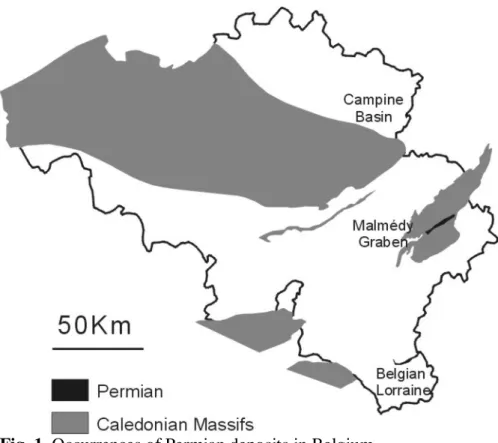PERMIAN UNITS IN BELGIUM Frédéric Boulvain
U.R. Pétrologie sédimentaire, B20, Université de Liège, Sart Tilman, B-4000 Liège, Belgium Permian formations are of minor importance in Belgium. Moreover, the Permian age of some of these units is most likely, but not proven. Continental deposits dominate with alluvial fans, river and fluvio-littoral red-coloured sediments. Three occurrences are considered (Fig. 1): the Malmédy Graben, in the Eastern Ardenne, the northern part of Belgian Lorraine, a north-eastern dependence of the Paris Basin and the subsurface of the Campine Basin, in the north eastern part of Belgium.
Fig. 1. Occurrences of Permian deposits in Belgium. The Malmédy Graben
The Malmédy Graben is a 2.5 km to 0.5 km wide and about 22 km long graben structure across the Caledonian Stavelot Massif, in the Eastern part of the Ardenne. Permian deposits rest on the folded and faulted Cambrian and Ordovician formations. These deposits form the Malmédy Formation (Bultynck et al, 2001), consisting in:
- A 15 to 60 m-thick lower member with a basal breccia with quartzitic clasts, overlaid by alternating microconglomeratic sandstones and conglomerates with argillaceous matrix and rounded sandstone or shale clasts;
- A 35 to 150 m-thick conglomeratic member with predominantly fossiliferous limestone clasts in a red calcareo-argillaceous matrix intercalated with sandstone-siltstone-mudstone lenses. The limestone clasts are dated from Emsian to Lower Carboniferous on the base of conodonts, corals and brachiopods. Main origin of the clasts is supposed to be the Eifel area.
- A 30 m-thick upper member with a breccia rich in shale, sandstone and quartz clasts with minor limestone elements in a red, argillaceous matrix.
All these units are considered as alluvial fan and river deposits. The Campine Basin
Permian to Lower Jurassic formations subcrop in the north-eastern Campine Basin and Roer valley graben (NE Belgium). Discovery of these concealed deposits is due to coal exploration of the Campine Basin. Permo-Triassic deposits display Germanic facies and are closely related to Dutch formations. Seismic surveys revealed that Permian unconformably overly the Carboniferous Coal Measures and gradually wedge out towards the south, near the Brabant Caledonian Massif.
Permian deposits form the Helchteren Formation (Dusar et al., 2001), composed of 5 members. This formation is dated from Latest Permian (Demaret et al, 1985) and is 0-45 m thick.
First member is a basal conglomerate with quartzite and limestone clasts, overlaid by grey silty carbonates alternating with marly mudstones and siltstones. Third member is grey to red silty mudstone with pedogenetic carbonate nodules, passing upwards to massive sandstones beds. And the last member is a red massive claystone with siltstone and sandstone
intercalations. This evolution corresponds to a transition from a shallow marine to a floodplain environment.
The Belgian Lorraine
The formations of Belgian Lorraine are a north-eastern dependence of the Paris Basin, forming the so-called Gulf of Luxemburg. The nature and the complex geometry of sedimentary bodies indicate a littoral environment characterized by a mixed sedimentation with a siliciclastic predominance. The sequential evolution of deposits was integrated in a globally retrograding sedimentary prism (Boulvain et al., 2001).
The first unit, the Habay Formation, with a marked continental character, rests unconformably on the Lower Devonian basement. Its thickness is, consequently, locally variable and reach about 30 m near the Luxemburg border. Until now, no dating method has provided a specific age of the formation. Depending on the authors, it is assigned a Permian or a Lower Triassic age. It consists of alternations of conglomerate with shale and sandstone clasts, sand,
argillaceous sand, conglomeratic dolomite and clay, generally brick-red, sometimes greenish. Pedogenetic features are ubiquitous.
References
Boulvain, F., Belanger, I., Delsate, D., Ghysel, P., Godefroit, P., Laloux, M., Monteyne, R. & Roche, M., 2001. Triassic and Jurassic lithostratigraphic units (Belgian Lorraine). In Bultynck & Dejonghe, eds., Guide to a revised lithostratigraphic scale of Belgium, Geologica Belgica, 4: 113-119.
Bultynck, P., Geukens, F. & Smolderen, A., 2001. Permian lithostratigraphic units, Malmédy Graben (Belgium). In Bultynck & Dejonghe, eds., Guide to a revised lithostratigraphic scale of Belgium, Geologica Belgica, 4: 105-106.
Demaret-Fairon, M., Dusar, M. & Streel, M., 1985. Permian stratigraphy in the Campine Basin. Annales de la Société géologique de Belgique, 108: 411-412.
Dusar, M., Langenaeker, V. & Wouters, L., 2001. Permian-Triassic-Jurassic lithostratigraphic units in the Campine Basin and the Roer Valley Graben (NE Belgium). In Bultynck &
Dejonghe, eds., Guide to a revised lithostratigraphic scale of Belgium, Geologica Belgica, 4: 107-112.
